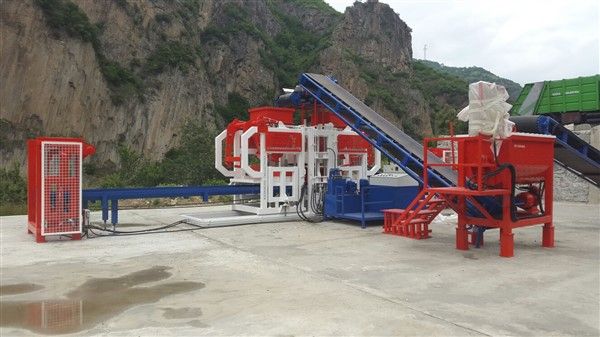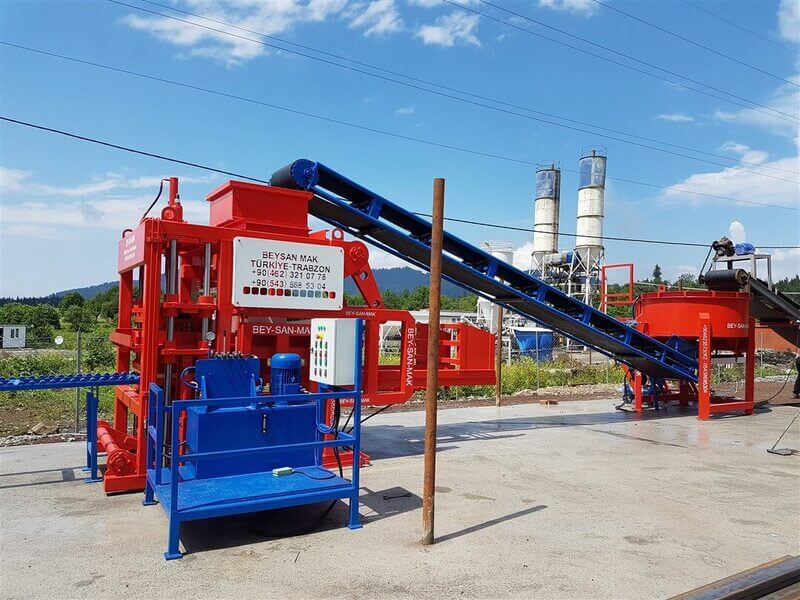Cement Brick Making Machine
Generally, a cement brick making machine is a machine that uses vibration and pressure on the mortar and molds to produce hollow concrete blocks. By changing the mold the concrete brick machine can produce hollow blocks, solid blocks, paving blocks, curbstones, grasscretes, roof gutters, and more than 400 different shapes with a height of 5cm to 30cm.
This machine is also called a brick making machine and has different automation levels and different capacities. We will discuss them one by one.

You may ask why cement is used instead of concrete in the name. It is because usually, people don’t know the difference between concrete and cement, Cement is the powder that is used with other raw materials and water to form the concrete in the shape of mortar.
About the brick, this is true as well. Before hollow blocks, people only used bricks and when these hollow blocks were created, people started to call them ''cement bricks''. It is not a correct name but it is commonly used.

People also call these machines different names when they produce different products. For example, when the block making machine produces paver blocks it is called a paver block machine.
When the machine produces hollow blocks it is called a hollow block machine.
The other difference between these two machines is that hollow block machines are single-hopper machines and paver block machines are double-hopper machines. You can click on their names to read more information about them.

Cement Brick Making Machine types
Cement Brick making machines have different types but globally it is categorized into two main types
- Mobile brick making machine
- Stationary brick making machine
Mobile Brick Making Machine
A mobile brick making machine is also called the bricklaying machine. It is way simpler than the stationary cement brick machines. It is cheaper as well, but the capacity and mold options are lower as well. This machine is capable of moving after it lays the bricks.

Talking about the pros and cons, this bricklaying machine moves after it lays concrete blocks. This machine doesn’t need pallets. It produces hollow blocks on the ground, this is an advantage but every machine in the world has its disadvantages as well. This machine is not a paver block machine it means it cannot produce concrete paving blocks and the capacity is low compared to stationary cement brick making machines.
The capacity of the mobile brick laying machine is between 2225 and 3750 pieces of standard hollow concrete blocks in eight hours.
The standard hollow block is a block with the dimensions 20cm(W) x 40cm(L) x 20cm(H)
Totally to operate this cement brick making machine you need 4 workers on the field, one worker will operate the machine, two workers supply the mortar needed for the machine, and one delivers mortar from the mixer to the machine.
The capacity of the mobile brick laying machine is shown in the table below:
Stationary Cement Brick Making Machine
As the name represents this machine is stationary. It is designed to produce different capacities and different types of concrete products. This machine uses pallets and molds to produce cement blocks.

First, aggregate is transferred to the field to supply the cement brick making machine then the machine automatically or semi-automatically delivers this aggregate to the mixer. Water and cement are added to the mixer in this step, then the mortar is formed. Mortar is then delivered to the machine and the machine uses molds and pallets to produce hollow concrete blocks. we use Siemens plc equipment in our machines.
When concrete blocks are formed, they need to get dried before they can be used.
To transfer the pallets to the drying section two choices are available:
- Manual pallet collecting system
- Automatic pallet collecting system
Each of both has advantages and disadvantages, manual pallet collecting system is cheap and simple, but it required more space to get dried because pallets are collected and delivered one by one, it consumes more time as well because it is done manually and slowly.

On the other hand, the automatic pallet collecting system is more expensive but it is done by robots that are mounted on the machine. Pallets containing the produced wet blocks are first stored on top of each other, when they reach five, they are delivered to the drying section to get dried.
With this system, you need smaller space for the drying section (five times smaller). Then the dried pellets are brought to the pallet feeding part of the machine and a robot takes the dried concrete blocks and delivers them to the euro pallets. It is true that the automatic block making machine is expensive, but the advantages far overweigh the price.
You can check the price details of this machine in the article ''concrete block machine description and price''.

The stationary cement brick making machine has some special options which can be added when ordering. for example, you can add a second hopper for the machine. with this option, you can produce two-layered paving blocks with different colors to make the paving blocks or other products more appealing. this machine is also called the paver block machine.

The smallest stationary cement brick making machine can produce 4 pieces of standard hollow blocks in one press. standard block means a block with the dimensions of 20cm*40cm*20cm(height). This machine is called PRS400.
The next stationary cement brick making machine can produce 6 pieces of standard hollow blocks in one press. this machine is called PRS600.
There are bigger sizes as well. The biggest size of the stationary machines is PRS1000.
The smallest stationary brick making machine can produce 4000 pieces of hollow concrete blocks and The biggest stationary cement brick making machine can produce 10000 pieces of hollow concrete blocks in eight hours.

The technical information on the stationary hollow block making machine is shown in the table below:
| Technical specification | |
| Mortar Hoppers and Capacity | Single Hopper /0.8 m³ |
| Control System | Operator Control |
| Production Capacity | 100-120 Pallets / Hour |
| Weight | 8.500 Kg |
| Machine Dimensions | 200 cm /550 cm / 250 cm |
| External Chassis Dimensions | 150 x 150 x 6 mm |
| Vibration Force | 36.500 Kg |
| Lower Vibrator Motor Power | 5,5 kW x 2 Pieces |
| Upper vibrator motor power | 0.75 kW x 2 Pieces opt |
| Hydraulic Motor Power | 5.5 kW |
| Hydraulic Oil Tank Capacity | 350 L |
| Hydraulic Pressure | 150 Bar |
| Vibration Cooling Capacity | 22.000 Kcal |
| Total Power Usage | 18 kW |
| Min - Max Product Height | 5-25 cm |
| Wooden Pallet Dimensions | 55 x 110 x 4 cm |
Cement Brick Making Machine Video
you can also visit our Bess youtube channel for more videos. We have prepared different references in our videos so you can choose easier. You can also contact us to see if we have a machine in your country. We have already installed 350 working plants in 32 countries.
The mortar Used In Producing Hollow Concrete Blocks
The basic mixture of the mortar is a 4-to-1 or 5-to-1 mixture. It means for every five parts of sand you need to add one part of cement and then you should add water until it you achieve the texture you want for your cement brick making machine. To produce a mixture that can be used in a cement brick machine you generally want a thick, creamy mixture that will stick but also endure the blocks' weight.
When adding water, you need to be more careful because too much water will make it difficult for the sand particles to bond with cement in the concrete.

You should also be careful with the amount of cement you are using for your cement brick making machine. Too much cement will cause cracks on the hollow concrete clocks when they are dried. you can sometimes go as low as three shovels of sand to one shovel of cement, anything beyond that does not provide you with a quality mortar that cures slowly and hardens the best.

Sand helps the hollow concrete blocks to withstand the weight of the wall. So make sure you use the right ratio in your mortar.
These days it is very important to make hollow blocks lighter in weight.
It can be achieved by mixing a lighter aggregate, such as perlite, vermiculite, or Styrofoam to reduce the overall weight.
Like always it has advantages and disadvantages. It is not as strong as the old mixture but it has better insulation than the traditional concrete.
This concrete is often used for countertops and rooftop decks, where a lighter weight is more important than a higher strength. it is also used for walls where insulation is more important than strength, such as offices.
Conclusion
You need to consider a lot of factors before starting your business.
Feel free to compare our quality with other brands. Bess company sales representatives help you do a logical comparison in terms of quality, capacity, and price.
if you are looking for a professional adviser to get the best hollow blocks business plan you can contact us:















